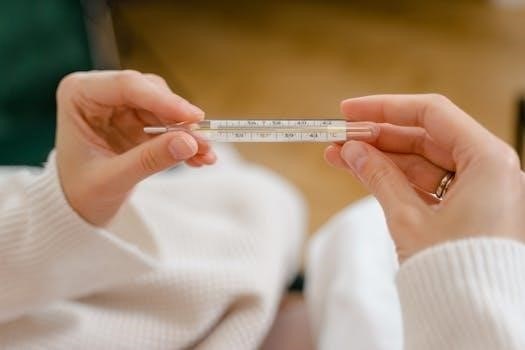Safety 1st Thermometer Manual⁚ A Comprehensive Guide
Welcome to your comprehensive guide to Safety 1st thermometers! This manual will help you understand how to use‚ maintain‚ and troubleshoot your Safety 1st thermometer for accurate temperature readings and peace of mind.
Safety 1st thermometers are designed with families in mind‚ offering a range of options for quick‚ easy‚ and accurate temperature readings. From forehead and ear thermometers to 3-in-1 models‚ Safety 1st provides solutions for various needs. These thermometers often feature fever alert indicators‚ backlit displays‚ and memory functions to help you monitor your family’s health effectively. Understanding the specific features and proper usage of your Safety 1st thermometer ensures accurate results and a less stressful experience when caring for a sick child. Always refer to the user manual for detailed instructions specific to your model.

Types of Safety 1st Thermometers
Safety 1st offers various thermometers‚ including forehead‚ ear‚ and 3-in-1 models. Each type utilizes different technologies to provide accurate temperature readings‚ catering to diverse preferences and needs within a family.
Forehead Thermometers
Safety 1st forehead thermometers‚ like the Simple Scan and Easy Read Dual Mode models‚ offer non-contact temperature measurement. The Simple Scan requires positioning one inch from the forehead‚ delivering a reading in one second with a fever alert. The Easy Read Dual Mode also functions as a liquid thermometer.
To take a forehead temperature‚ align the red LED dots directly on your child’s forehead. When the dots are aligned‚ press the read button for a quick and easy reading. These thermometers often feature backlit displays and night modes for convenience.
Ear Thermometers
Safety 1st ear thermometers‚ such as model 49501B‚ provide a quick and convenient method for taking a child’s temperature. These thermometers measure infrared heat inside the ear canal. To ensure accuracy‚ it’s crucial to follow the specific instructions in your user manual.
Typically‚ you’ll need to gently insert the probe into the ear canal and press a button to initiate the reading. Some models have features like a one-second reading time. Remember to clean the thermometer before first use for personal hygiene‚ as per the safety guidelines.
3-in-1 Thermometers (Oral‚ Rectal‚ Underarm)
Safety 1st 3-in-1 thermometers‚ like the Rapid Read model‚ offer versatile temperature-taking options. These thermometers can be used orally‚ rectally‚ or under the arm‚ providing flexibility for different age groups and preferences. Each method requires slightly different techniques to ensure accuracy.
The Rapid Read 3-in-1 thermometer delivers results in under a minute. Always clean the thermometer thoroughly before and after each use. Refer to the user manual for specific instructions on proper placement and usage for each method to achieve the most reliable readings.

Using a Safety 1st Thermometer⁚ Step-by-Step Instructions
This section provides detailed‚ step-by-step instructions for using your Safety 1st thermometer. We will cover forehead‚ ear‚ and 3-in-1 models‚ ensuring accurate temperature readings every time.
Taking Forehead Temperature
To take a forehead temperature using a Safety 1st thermometer‚ ensure the forehead is clean and dry. For the Simple Scan model‚ position the thermometer approximately one inch from the center of the forehead. Press the measure button and wait for the beep‚ which indicates the reading is complete.
With the Easy Read Dual Mode Thermometer‚ align the red LED dots on the forehead until they overlap‚ then press the read button. A reading will appear in just one second! Refer to your specific model’s manual for detailed instructions and any unique features;
Taking Ear Temperature
When using a Safety 1st ear thermometer‚ first ensure the ear canal is clean and free of wax. Gently pull the ear back and upward (for adults) or straight back (for children under one year) to straighten the ear canal.
Insert the thermometer probe snugly into the ear canal‚ aiming towards the eardrum. Press the scan or measure button and hold it until the thermometer beeps‚ indicating the reading is complete. Refer to your specific Safety 1st ear thermometer model for detailed instructions and any unique features it may offer for accurate readings.
Taking Oral‚ Rectal‚ or Underarm Temperature
The Safety 1st Rapid Read 3-in-1 Thermometer offers versatile temperature-taking options. For oral use‚ place the thermometer tip under the tongue and close the mouth until a beep signals completion.
For rectal readings‚ lubricate the tip and gently insert it about an inch into the rectum. When using it under the armpit‚ ensure the armpit is dry‚ place the tip firmly in the center‚ and hold the arm close to the body. Always clean the thermometer thoroughly after each use‚ regardless of the method.
Understanding the Display and Features
Familiarize yourself with your Safety 1st thermometer’s display. Key features often include fever alert indicators‚ a backlit display for easy reading‚ and a memory function to track previous temperature readings.
Fever Alert Indicators
Safety 1st thermometers often feature fever alert indicators‚ providing a quick visual cue about the temperature level. These indicators may use color-coded displays or specific symbols to signal a normal‚ elevated‚ or high temperature. The Safety 1st Precise Position Forehead Thermometer even includes a fever light and beeping sound. Understanding these indicators is crucial for quickly assessing the situation and determining the appropriate course of action. Always refer to your specific model’s manual for a detailed explanation of its fever alert system.
Backlit Display
Many Safety 1st thermometers come equipped with a backlit display‚ enhancing visibility in low-light conditions. This feature is particularly useful when checking a child’s temperature at night without disturbing their sleep. The large‚ illuminated screen makes it easy to read the temperature quickly and accurately. The Safety 1st Easy Read Dual Mode Thermometer has a large backlit display. Ensure the backlight is functioning correctly for optimal use. Refer to your thermometer’s manual for instructions on activating or adjusting the backlight settings.
Memory Function
The memory function on Safety 1st thermometers allows you to store previous temperature readings for easy tracking. This feature is helpful for monitoring temperature changes over time and providing accurate information to healthcare professionals. To access the memory function‚ consult your thermometer’s user manual for specific instructions. The thermometer stores the values even after turning it off. Reviewing past readings can help you identify fever patterns and assess the effectiveness of treatment. This enables informed decisions about your family’s health.
Cleaning and Maintenance
Proper cleaning and maintenance are crucial for ensuring the accuracy and longevity of your Safety 1st thermometer. Regular cleaning prevents the spread of germs‚ while proper maintenance guarantees reliable performance.
Cleaning Instructions
To maintain hygiene and ensure accurate readings‚ regular cleaning of your Safety 1st thermometer is essential. Before cleaning‚ always ensure the thermometer is switched off. For most models‚ gently wipe the probe or sensor with a soft cloth dampened with isopropyl alcohol (70%). Avoid using abrasive cleaners or submerging the thermometer in water‚ as this can damage the internal components. Pay special attention to the sensor area‚ removing any visible residue. Allow the thermometer to air dry completely before storing it in a clean‚ dry place. Refer to your specific model’s manual for detailed cleaning instructions.
Battery Replacement
When the battery is low‚ your Safety 1st thermometer will display a low battery indicator. To replace the battery‚ locate the battery compartment‚ usually on the back or side of the device. Open the compartment using a small screwdriver if necessary. Remove the old battery and replace it with a new battery of the correct type (typically CR2032 or AAA‚ as specified in your manual). Ensure the battery is inserted with the correct polarity (+ and -). Close the battery compartment securely. Dispose of the old battery responsibly‚ following local regulations.
Troubleshooting Common Issues
Encountering issues with your Safety 1st thermometer? This section addresses common problems like inaccurate readings and error messages. We provide simple solutions to help you get back to accurate temperature monitoring quickly.
Inaccurate Readings
If your Safety 1st thermometer shows inconsistent or questionable temperature readings‚ several factors could be the cause. First‚ ensure the thermometer is clean and the sensor is free of any debris. For forehead thermometers‚ position it one inch from the center of the forehead. With ear thermometers‚ confirm proper insertion into the ear canal. Always verify the battery is adequately charged‚ as a low battery can lead to inaccurate results. Furthermore‚ be mindful of environmental conditions; external factors can also influence readings. When in doubt‚ consult your Safety 1st thermometer manual.
Error Messages
Encountering an error message on your Safety 1st thermometer can be frustrating‚ but it usually indicates a specific issue. Refer to your user manual to decipher the meaning of the error code displayed. Common causes include incorrect positioning‚ ambient temperature outside the operating range‚ or a malfunction with the sensor. Try re-taking the temperature‚ ensuring correct usage. If the error persists‚ replacing the batteries or contacting customer support might be necessary. Always consult the manual for a comprehensive list of error codes and troubleshooting steps specific to your thermometer model.

Safety Precautions
Prioritize safety when using your Safety 1st thermometer. Always follow the guidelines in the manual to ensure accurate readings and prevent injury‚ especially when taking rectal temperatures on infants and young children.
General Safety Guidelines
Before using any Safety 1st thermometer‚ carefully read all instructions and safety warnings provided in the user manual. Clean the thermometer before each use to maintain hygiene and accuracy. Never leave a child unattended while taking their temperature. Ensure the thermometer is used only for its intended purpose – measuring body temperature or‚ in some models‚ food or bathwater temperature. Store the thermometer in a safe place‚ out of reach of children. Inspect the thermometer regularly for any signs of damage. If damaged‚ discontinue use to prevent potential harm. Always consult a healthcare professional for medical advice.
Specific Precautions for Different Thermometer Types
For forehead thermometers‚ ensure the sensor is clean and positioned correctly‚ typically one inch from the center of the forehead. With ear thermometers‚ use a fresh probe cover for each use to avoid contamination. For rectal thermometers‚ use lubricant and insert gently‚ avoiding forcing the device. Oral thermometers should be placed under the tongue for an accurate reading. When using underarm thermometers‚ ensure the armpit is dry and the arm is held firmly against the body. Always follow the specific instructions provided for your thermometer model to ensure accurate readings and prevent injury.

Where to Find Manuals and Support
Need more assistance? Find Safety 1st thermometer manuals and support online through their website. Contact customer service for personalized help with any questions or concerns you may have.
Online Resources
For Safety 1st thermometer support‚ start with the official Safety 1st website‚ where you can often find downloadable user manuals for specific thermometer models. Look for FAQs‚ troubleshooting guides‚ and instructional videos that demonstrate proper usage and maintenance. Many online retailers that sell Safety 1st thermometers also provide links to product manuals or customer review sections where users share helpful tips and solutions to common issues. Additionally‚ check video platforms for user-created content demonstrating thermometer operation.
Customer Service Contact Information
If you require direct assistance with your Safety 1st thermometer‚ reaching out to their customer service is a good option. Typically‚ Safety 1st provides a customer service phone number on their website or within the product packaging. You can also look for an email address or a contact form on their website to submit your inquiries. Be prepared to provide the model number of your thermometer and a detailed description of the issue you’re experiencing for efficient support.
